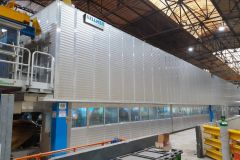Today, sustainable development in a company is no longer a matter of personal convenience, it is both a regulatory and competitive obligation. For many years, the graphic arts industry has been able to rely on new technologies to reduce its environmental impact. And some of the digital technologies that continue to grow in power and popularity are precisely in line with this need to be green.
Here's how production inkjet technology is helping companies minimize their environmental impact.
1. Just the right amount of print
The major and undeniable advantage of the inkjet printing system compared to other printing technologies is the flexibility it provides. It allows to print very short runs while remaining competitive. The precise amount of printed material needed can be printed.âeuros¨ By printing that right amount, digital printing helps protect the environment, avoiding the destruction of excess print as well as reducing chemical consumption, waste production and eliminating the storage of unused documents.
2. Extremely low power consumption
The second environmental strength of inkjet systems is their low power consumption. Inkjet printers require far less energy than other digital technologies, especially laser printing.
Unlike inkjet, laser technology is based on raising the temperature of the toner and maintaining this heat throughout the printing process to fix the color on the paper.
Kyocera's TASKalfa Pro 15000c color inkjet production printer has a typical power consumption (TEC) of 6.3 kW/week, representing one of the most energy-efficient products available in the category.
This printer has also received numerous environmental certifications guaranteeing low energy consumption (Energy Star, EPEAT, RoHS or EcoMark).
3. Unbeatable marketing effectiveness
The other key advantage of inkjet is that it offers the ability to print large quantities of fully customized documents.
Printers can now avoid the tedious process of combining pre-printing in offset and transfer printing in order to add only a few variable data elements in a second pass in digital. For the same amount of money, a single inkjet operation can be performed to personalize an entire document. Less printing material and less impact on the environment.
And this inkjet capability - more cost-competitive than laser - is a perfect fit for the growing trend toward more personalized marketing content. So inkjet is in a strong position in terms of both technological evolution and environmental advantage.
With its innovative variable print capability, low energy requirements and minimal printing, inkjet makes production printing even more environmentally sustainable. This technology gives companies the means to print more sustainably, while saving them money, creating a win-win for everyone in the value chain.








